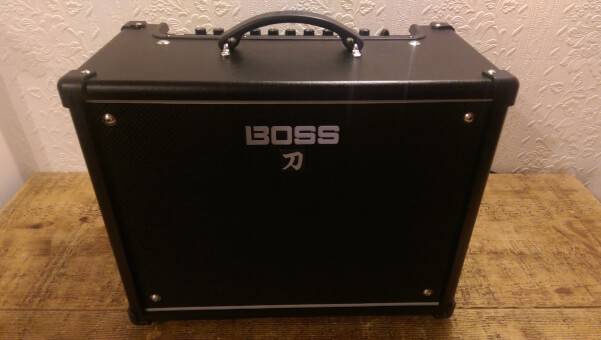If tone is your only concern. The BOSS Katana can’t compete with more expensive valve guitar amps. Let me try to explain why.
I’ve been a supporter of the BOSS Katana range of amps for years. But how do they really compare with traditional valve guitar amps? I’ve already covered the benefits of the BOSS Katana series of amps extensively on these pages, and, as a gigging tool and faithful, reliable companion, I’m sold. Hook, line, and sinker. I’ve said it many times.
The BOSS Katana is the best musical instrument purchase you’ll ever make.
However, if tone is your only concern. Most players prefer the mysterious blue glow of glass to a box of transistors. Why is that?
Inspiration
I’ve mentioned before that the BOSS Katana got me to my ballpark tone I need to gig with, which it achieves with the minimum of fuss, but the point here is, the Katana’s not giving me any new ideas, it’s not inspiring me. It’s a predictable black noise box as opposed to a valve amp which is an instrument in itself. Yes, it’s inconsistent, unreliable, and, at times, a downright pain, but it’s that unpredictability that provides the creative spark the Katana sadly lacks.
Case in point: My old Marshall JCM2000 DSL 401 combo. Bad design (it ran stupidly hot and melted its own circuit board) which made it a no-no for gigging, but it introduced me to the most beautiful, sweet low-gain Les Paul neck pickup tone I’d ever heard. So much so, I felt compelled to write songs around it. The BOSS Katana is just not capable of doing that.
Warmth
Sounds are notoriously difficult to describe, but the BOSS Katana, although it can match the volume and gain levels of valve amps, can’t match their intrinsic warmth. There’s always that slightly buzzy top-end to dial out, which more often than not ends up producing mud. Tonally, the BOSS Katana is always a bit of a compromise and needs more fiddling to get right.
Valve Power Amp Overdrive
Valve power amp overdrive is a beautiful thing, occurring when a valve amp is pushed towards the max volume and imparting a uniquely organic overdrive to your tone. Many guitarists swear by this, as the character is much more natural-sounding than the fizzier pre-amp overdrive.
The BOSS Katana aims to emulate this with its solid-state technology, and indeed the tone does break up at higher volumes, but the effect lacks impact.
Authenticity
This is going to sound shallow, but owning the real thing: an expensive valve amplifier, feels good. And the bigger the brand and the price tag, the better it feels.
But there’s more to it than that. A lot more. Confidence is the obvious one, but in general, how you feel has a lot to do with your guitar playing. The bottom line is you’re going to feel a lot better gigging (or recording) with a £2k boutique valve amp than a £200 BOSS Katana. Although nobody will ever prove it, the better you feel, the better you play.
EQ
I’m going to use my old Cornford Roadhouse 30 as an example here. It sounds inconsequential but the EQ on that amp was so musically predictable it made all other amps look like toys. On the BOSS Katana, you’re always fighting the EQ, too much treble and it’s like a buzzsaw, too little and you’re lost in the mix. Middle? past 12 o’clock equals more mud and the bass was just a woofiness control really.
But the Cornford was so user-friendly, so predictable, so natural. Add more bite with the treble that never became too shrill, more bark with the middle that just got woodier with no mud whatsoever, and deploy the proper bottom-end of the pine cabinet with the bass control.
Conclusion
Granted, the BOSS Katana costs a fraction of most valve guitar amps, but I hope this article explains why a lot of players will always prefer the characteristics of a good old fashioned valve amp. Thanks for reading!
What do you think? Drop me a comment below.

Leave a Reply